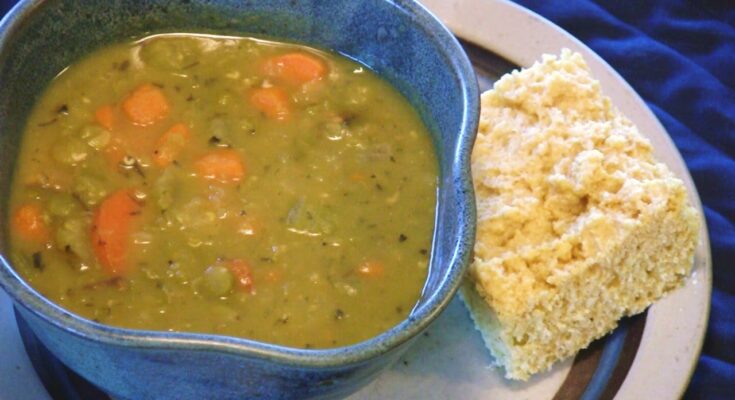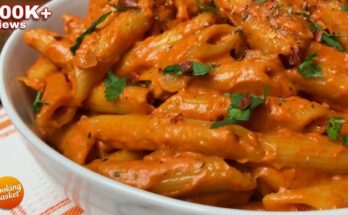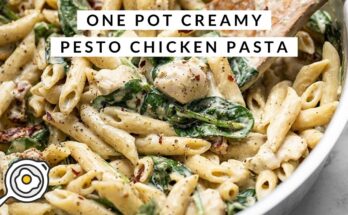Vegetarian Split Pea Soup Recipe: When you think of cozy, heartwarming meals that hug you from the inside out, split pea soup has to be somewhere near the top of that list. But let’s take it a step further: a vegetarian split pea soup. It’s simple, deeply nourishing, and layered with flavor without needing a single ounce of meat. Whether it’s a chilly autumn evening or you’re just craving something warm and wholesome, this soup hits the spot.
Now, most traditional split pea soups are made with ham hocks or bacon. But this meat-free version brings all the flavor using fresh vegetables, hearty legumes, and herbs. The beauty of vegetarian cooking is that it lets the ingredients shine on their own, and trust me, split peas are the kind of ingredient that love a chance to shine.
You don’t have to be vegetarian or vegan to appreciate this recipe. It’s the kind of dish that makes you feel good after eating it. Full of fiber, loaded with vitamins, and rich in taste – what more could you ask for? Plus, it’s easy on the wallet and great for meal prepping.
Health Benefits of Split Peas
Before we dive into the recipe, let’s take a second to appreciate the humble green split pea. These tiny legumes are nutritional powerhouses. High in protein, packed with fiber, and naturally low in fat, they support digestion, help stabilize blood sugar levels, and keep you feeling full for longer.
Here are some key health benefits:
- Excellent plant-based protein: Great for vegetarians and vegans.
- High in soluble fiber: Promotes gut health and reduces cholesterol.
- Rich in vitamins and minerals: Especially folate, magnesium, potassium, and iron.
- Low on the glycemic index: A great food for managing energy levels.
And the best part? You don’t have to soak them overnight like other legumes. Just rinse and toss them in the pot.
Ingredients You’ll Need
Let’s get to the good stuff—what you’ll need to cook this up. This vegetarian split pea soup uses basic pantry and fridge staples, but when combined, they create a bold, comforting bowl of goodness.
Fresh Vegetables for a Flavorful Base
The magic of this soup starts with a base of aromatics and fresh veggies. Here’s what to grab from the produce aisle:
- 1 large yellow onion, diced
- 2 cloves of garlic, minced
- 2 medium carrots, peeled and chopped
- 2 celery stalks, chopped
- 1 medium Yukon gold potato (optional, for added creaminess), diced
These vegetables create a savory base that mimics the richness of meat-based broths. The onion and garlic add depth, while carrots and celery bring sweetness and balance.
Pantry Staples to Keep On Hand
Split pea soup doesn’t require anything fancy, but it helps to have a few pantry MVPs ready to go:
- 1½ cups dried green split peas, rinsed
- 6 cups vegetable broth (low sodium preferred)
- 2 tablespoons olive oil
- 1 bay leaf
- Salt and black pepper, to taste
The star here is obviously the split peas—cheap, filling, and nutritious. Using vegetable broth instead of water boosts flavor without needing bouillon or MSG.
Herbs and Seasonings for the Perfect Taste
To really make your soup sing, you’ll want to use a few simple seasonings. Here’s what I recommend:
- 1 teaspoon dried thyme
- ½ teaspoon smoked paprika (for a subtle smoky flavor)
- ½ teaspoon ground cumin (optional, but adds a warm earthiness)
- Fresh parsley, for garnish
- Lemon juice or apple cider vinegar – just a splash at the end for brightness
You’ll be surprised how just a few dried herbs can elevate a humble pot of soup into something crave-worthy. The touch of smoked paprika gives it a rich, savory flavor that makes you forget it’s vegetarian.
Equipment Required
You don’t need a gourmet kitchen or high-end tools to make this soup. But having the right gear helps things run smoothly.
Essential Cooking Tools for Soup-Making
Here’s a quick rundown of the basic kitchen equipment you’ll need:
- Large soup pot or Dutch oven – At least 5-quart capacity
- Wooden spoon or spatula – For stirring without scraping your cookware
- Chef’s knife and cutting board – For all your chopping needs
- Measuring cups and spoons – Accuracy matters!
- Ladle – To serve up that steaming goodness
A Dutch oven is especially useful because it retains heat evenly, which helps with even cooking and simmering.
Optional Kitchen Gadgets for Easier Prep
While not essential, these tools can save you time and effort:
- Immersion blender – For a creamier texture without transferring hot soup to a blender
- Food processor – To speed up chopping veggies
- Soup storage containers – For meal prepping and freezing leftovers
An immersion blender is a game-changer if you prefer smooth soups. But even if you like it chunky, a few quick pulses can help thicken the soup naturally.
Preparation Tips Before You Start
Before you turn on the stove, let’s set ourselves up for success. These simple prep steps can make your cooking experience faster, smoother, and more enjoyable.
How to Sort and Rinse Split Peas Properly
Split peas are usually clean right out of the bag, but it’s still a good idea to sort through them. Occasionally, you might find small stones or debris. Spread the peas on a baking sheet or clean towel and check them over.
Next, rinse them thoroughly in a fine-mesh strainer under cold water. You’ll see some foam or bubbles – that’s normal. Rinsing helps remove excess starch and prevents the soup from becoming too frothy during cooking.
Chopping Vegetables for Uniform Cooking
Uniformity is key here. If your carrot chunks are huge and your celery is tiny, some pieces will overcook while others stay raw. Aim to chop all veggies into similar-sized pieces, especially the carrots and potatoes, since they take longer to cook.
Pro tip: dice onions and garlic finely so they melt into the soup, creating a smooth, flavorful base.
Storing Prep Work for Later Use
Short on time? You can prep everything ahead of time:
- Chop your veggies and store them in an airtight container in the fridge for up to 2 days.
- Measure your dry split peas and seasonings into separate jars or containers.
- You can even sauté your aromatics (onions, garlic, celery) a day early and refrigerate them.
Meal prep like this makes it so much easier to whip up soup midweek without feeling overwhelmed.
Step-by-Step Cooking Guide
Now that you’ve got all your ingredients prepped and your equipment ready, it’s time to bring everything together. Let’s walk through the cooking process, one step at a time.
Step 1 – Sautéing the Aromatics
Heat 2 tablespoons of olive oil in a large pot over medium heat. Add chopped onions, carrots, celery, and garlic. Sauté for 5 minutes until fragrant and slightly softened.
Step 2 – Adding Vegetables and Building Flavors
Stir in diced potatoes and a pinch of salt, pepper, thyme, and smoked paprika. Cook for another 2 minutes to layer the flavors.
Step 3 – Incorporating Split Peas and Liquid
Add 1½ cups of dried split peas and 6 cups of vegetable broth. Stir well and bring to a boil.
Step 4 – Simmering to Perfection
Reduce heat, cover partially, and simmer for 45–60 minutes, stirring occasionally until the peas are tender and creamy.
Step 5 – Blending (Optional) and Final Seasoning
For a smoother texture, blend part or all of the soup. Adjust seasoning and serve warm with crusty bread—hearty, wholesome, and full of comfort!
Cooking Variations
One of the best things about vegetarian split pea soup is how versatile it is. Don’t be afraid to tweak the recipe based on your schedule, tools, or preferences. Here are some great alternatives:
Slow Cooker Method
Want to make this soup with zero fuss? The slow cooker is your friend.
How to do it:
- Add all ingredients to your slow cooker.
- Stir to combine.
- Cook on low for 8 hours or high for 4-5 hours.
- Blend if desired, then season to taste.
This method is ideal for meal-prep days when you just want to throw everything in and come back to a hot, delicious soup.
Instant Pot Method
Pressed for time? The Instant Pot version gives you the same great flavor in a fraction of the time.
Instructions:
- Use the sauté function to cook your aromatics.
- Add the rest of the ingredients and stir.
- Seal the lid and cook on High Pressure for 15 minutes.
- Let the pressure release naturally for 10 minutes, then quick-release the rest.
- Open the lid, stir, blend (optional), and serve.
Just make sure you don’t overfill the pot—split peas expand!
Creamier Texture with Coconut Milk or Plant-Based Cream
Want a luscious, creamier soup without using dairy? Just stir in ½ cup of coconut milk, cashew cream, or your favorite non-dairy milk at the end of cooking.
This takes your soup from homey to restaurant-quality—perfect for impressing guests or just treating yourself on a cozy night in.
The slight sweetness of coconut milk also pairs beautifully with the earthy flavor of split peas.
Nutritional Information
One of the best things about vegetarian split pea soup? It’s packed with nutrients while still being incredibly budget-friendly and satisfying.
Let’s break it down per one 1½ cup serving (estimated):
| Nutrient | Amount |
|---|---|
| Calories | 270 |
| Protein | 16g |
| Carbohydrates | 38g |
| Fiber | 14g |
| Fat | 6g |
| Saturated Fat | 1g |
| Sodium | 540mg (depends on broth) |
| Iron | 15% DV |
| Potassium | 20% DV |
This soup is naturally:
- ✅ Vegan
- ✅ Gluten-free
- ✅ High in fiber
- ✅ Low in fat
- ✅ Rich in plant-based protein
If you’re tracking macros or eating with dietary restrictions, this soup checks all the boxes.
Serving Suggestions
Sure, split pea soup is delicious on its own, but pairing it with the right side dishes and garnishes can take it to the next level.
What to Serve with Split Pea Soup
- Crusty sourdough bread or whole wheat rolls
- Grilled cheese sandwiches (use plant-based cheese for a vegan option)
- Simple green salad with lemon vinaigrette
- Roasted vegetables like Brussels sprouts or sweet potatoes
- Savory muffins (try a cornmeal-jalapeño version!)
This soup is hearty enough to be a meal on its own, but the right side can round it out beautifully.
Garnish Ideas to Elevate Presentation
Want to make your bowl Instagram-worthy? Try these garnishes:
- Chopped fresh parsley or chives
- A swirl of coconut cream or olive oil
- Toasted pumpkin seeds or sunflower seeds for crunch
- Freshly ground black pepper
- A lemon wedge on the side
Not only do these garnishes boost flavor, but they also add texture and visual appeal.
Storage and Reheating Tips
One of the best things about vegetarian split pea soup is how well it stores. Whether you’re meal prepping for the week or saving leftovers for a lazy night, this soup is a star when it comes to storage and reheating.
How Long It Lasts in the Fridge
Once your soup has cooled down to room temperature, transfer it into airtight containers. Properly stored, it will last in the refrigerator for up to 5 days. In fact, many people say it tastes even better the next day because the flavors continue to develop and deepen.
Pro tip: Store in single-serve containers to make reheating faster and easier throughout the week.
To avoid bacterial growth, don’t leave the soup out on the counter for more than 2 hours after cooking. And never place hot soup directly in the fridge—let it cool down first.
Freezing and Thawing for Meal Prep
Want to make a big batch and freeze it? Go for it! This soup freezes extremely well. Here’s how:
To freeze:
- Let the soup cool completely.
- Ladle into freezer-safe containers or resealable freezer bags (lay bags flat to save space).
- Label with the date and contents.
- Freeze for up to 3 months.
To thaw and reheat:
- Thaw in the refrigerator overnight, or place the container in a bowl of warm water to loosen it up.
- Reheat on the stovetop over medium heat, adding a splash of water or broth to loosen the texture if needed.
The soup may thicken slightly in the fridge or freezer. Don’t worry—that’s totally normal. Just stir in a bit of extra liquid when reheating, and it’ll be good as new.
Common Mistakes to Avoid
Making split pea soup isn’t complicated, but a few small missteps can affect the final result. Let’s talk about what not to do so your soup turns out perfectly every time.
Overcooking or Undercooking Split Peas
Split peas can be a bit unpredictable. Depending on how old they are and how they’ve been stored, cooking times may vary.
Undercooked peas will stay firm and won’t break down into that smooth, creamy consistency you want. On the flip side, overcooked peas can lead to mushy texture and a burnt bottom if you’re not stirring.
Solution: Start checking for doneness around the 45-minute mark and stir frequently as it thickens. If they’re still too firm, give it more time and check every 10 minutes.
Skipping Seasoning Steps
Some people make the mistake of throwing all the ingredients in a pot and hoping for the best. The result? A flat, bland soup.
Why it matters: Proper seasoning at each step brings the soup to life. Sautéing aromatics, blooming spices, tasting as you go—these aren’t just fancy cooking tips. They’re essential to getting a soup that makes your taste buds dance.
Don’t forget: Always finish with a splash of acid (like lemon juice or vinegar). This simple step brightens all the flavors.
Budget-Friendly Meal
If you’re looking for a meal that’s affordable, nutritious, and filling, vegetarian split pea soup checks every box. It’s no wonder this recipe is a go-to for families, students, and budget-conscious foodies.
How This Soup Saves You Money
Split peas are one of the cheapest sources of protein you can buy. A 1-pound bag costs just a couple of dollars and makes enough soup to feed a family for days.
On top of that:
- Vegetables like carrots, onions, and celery are inexpensive.
- You don’t need any meat or dairy.
- Most ingredients are shelf-stable and can be bought in bulk.
Let’s break it down:
- Split peas (1.5 cups): $1.00
- Vegetables: ~$2.50
- Spices, broth, oil (portion cost): ~$1.50
That’s roughly $5 total for 6–8 servings, or less than $1 per bowl.
Buying Ingredients in Bulk
To save even more:
- Buy split peas, spices, and broth in bulk from warehouse stores or local co-ops.
- Store dry split peas in airtight containers in a cool, dark pantry—they can last up to a year.
- Keep chopped veggies in the freezer for faster prep (many stores sell frozen mirepoix blends too).
This soup is proof that you don’t need to spend big to eat well.
Kid-Friendly Tips
Worried your kids won’t go for green soup? You’d be surprised. With the right tweaks, split pea soup can be a hit—even with picky eaters.
Making It Appealing for Picky Eaters
Here’s how to help kids fall in love with this nutritious dish:
- Blend it smooth: A creamy texture makes it feel more like mashed potatoes than veggie soup.
- Serve it with fun dippers: Try toasted pita triangles, grilled cheese sticks, or veggie crackers.
- Add a little sweetness: A dash of maple syrup or a sprinkle of cinnamon can make the flavor more kid-friendly.
- Rename it: Sometimes, it’s all in the name—call it “super green power soup” or “magic pea potion.”
Get your kids involved in the kitchen too—when they help cook, they’re more likely to eat what they’ve made.
Reducing Spices Without Losing Flavor
Some kids are sensitive to bold flavors or spices like cumin or paprika. No problem—just leave them out. You can still get tons of flavor from:
- Sautéed onions and garlic
- Herbs like thyme and bay leaf
- A splash of lemon juice at the end
You can also serve the soup plain for the kids and add extra seasoning to your own bowl.
FAQs about Vegetarian Split Pea Soup Recipe
1. Can I use frozen vegetables in this soup?
Yes! Frozen onions, carrots, and celery (often sold as mirepoix) work great and save time.
2. What type of potato works best?
Yukon Gold or red potatoes are perfect—they hold their shape but still get creamy when cooked.
3. Is this soup good for weight loss?
Absolutely. It’s low in fat, high in fiber, and keeps you full longer without high calories.
4. How do I make this recipe oil-free?
Skip the olive oil and sauté veggies in a splash of broth or water instead—it still works beautifully.
5. Can I double the recipe?
Yes! This recipe doubles well. Just make sure your pot is large enough, or split it between two.
Conclusion
There’s something truly comforting about a bowl of vegetarian split pea soup. It’s warm, hearty, and brimming with flavor—even without a trace of meat. Whether you’re a seasoned vegetarian, a curious omnivore, or just someone looking to eat more plant-based meals, this soup delivers every time.
With simple, affordable ingredients and easy-to-follow steps, this recipe makes it possible for anyone to enjoy a homemade meal that feels like a hug in a bowl. From busy weeknights to lazy Sundays, from cold winter days to fresh spring evenings, vegetarian split pea soup is always a good idea.
Try it once, and it might just become your go-to comfort food.



